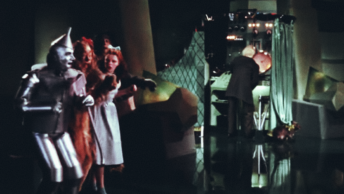My wife and I decided to move to a new home in Georgia last year. At our ages it was probably not a smart life change but sometimes you just have to push the envelope near the edge of the table. After nine arduous months of waiting for the home to be completed, our lives were literally suspended between a small condo in Florida and visiting family in a neighboring Georgia town. The unloading of 38,500 pounds of stuff since our closing in August, not to mention our mutual first bout with Questa Cosa after six shots, has been exhausting. Fortunately, there has been a positive side to this.
I know the Pope condemns materialism and too many of us are hung up on what we own or have. But perhaps he is missing something human in his pronouncements. Our stuff, much of which Anna and I had to merge after our January wedding, nearly five years ago, is not just stuff but is representative of memories and stories about our lives. It has a very strong spiritual side to it. Our best memories are often wrapped in a favorite hat, dress, picture or correspondence. They help make us human. Private property is a basic right and without it we would all be slaves.
We have not seen most of our possessions during their nine months of gestation in storage. Opening each one of our 400+ boxes has been like finding an old friend and renewing an old relationship. This has been especially true of my boxes of favorite articles, stacks of books, family albums and many articles I have written. From the very first article that I ever got published, an academic piece I wrote in 1974 for the Lincoln Quarterly, quickly followed by my first professional article, a profile of St. Louis Cardinals rookie, Ken Reitz, to the last essay I sent to this publication, they all opened memories and stimulated my thoughts. It has been a veritable trip down memory lane for me. One in particular reminded me of my coaching baseball with and against my boys over the years. It helped enrich our relationships by sharing those memories.
One of the first articles I stopped to read was one I had written in June of 1993 for the West County Journal in the generic column, known as The Opinion Shaper. The editor called it Ward Clever’s father image bears emulating. I started with an anecdote of my 23-year-old daughter who had a puppy, named Murphy. I called her the yuppie with a puppy. After months of reading books, training and trying to cope with him, she had to put him up for adoption. She did much better with her daughter, who is back at Tuft’s University for her sophomore year.
The name of the dog reminded me of the Murphy Brown/Dan Quale Debate that was going on at that time. It was over family values. It centered on Murphy’s unwanted pregnancy on her eponymous show. While she did eventually choose the baby, which was her estranged husband’s child, over the abattoir, to her it was just another lifestyle choice with little moral significance. That led me to my exposition on family moral values. I included such virtue-producing ideas as truthfulness, sexual fidelity in marriage, sobriety and self-sacrifice among others.
After reading this and several other of my past essays, one thing struck me as especially prescient. For nearly 40 years I have been critiquing our culture, especially the nationalization of abortion in 1973. That beat still goes on. Emanating from Roe has been a myriad of other issues that have changed the very cultural fabric in ways from which it may never recover. For instance, I had stored the articles for this piece in an old folder, which had a picture of Donald De Marco and Benjamin Wiker’s book jacket, Architects of the Culture of Death, published in 2004.
What surprised me is how my library of the books on the subject have not really changed over the last 50 years. In fact, I had written a book, Liberalism: Fatal Consequence, for a small press in 1998. My shelves bristle and groan with dozens of similar titles, some of which bear a 2021-22 publication date.
Like my father, I saved virtually everything and anything that I thought might have a future use. I found an old article, written by my favorite intellectual, the late Joseph Sobran. I have almost a 100 of his old essays, many of which are still relevant. The one caught my eye immediately was something he wrote for National Review in 1974. Entitled The Sage and Serious Doctrine of Hugh Hefner, the Founder and Godfather of Playboy Magazine.
For decades, most critics of Hefner’s magazine misunderstood the true purpose of his publication of explicit photos of completely nude women. Hugh Hefner was a pseudo intellectual who used nude women, not only to satisfy his lust, but to sell an idea of the Good Life to the American people. The pictures of the girl next store were the lure to get his quasi sophisticates to read the doctrinal bait that Heffner correctly reasoned could change what he viewed as an overly prudish Christian culture.
According to Sobran, Playboy is much more than a girlie magazine. There have been nude magazines before and after its publication in 1953. What made it essentially and critically different was what William F. Buckley, called the magazine within the magazine. By this he meant the articles and the interviews. The statement offered by many young men was I buy Playboy, mainly for the articles. However, this prompted comedian Rita Rudner to say: And I go to shopping malls for the music. Personally, I think the former is more a truism than people thought then.
The inside magazine attracted interview subjects, such as John Wayne, Frank Sinatra, Steve Jobs, and Rush Limbaugh. Buckley, considered by many to have been a devout Catholic, had no qualms about contributing his thoughts for the publication as did a number of other Catholics and clergymen. Other contributors included such diverse thinkers, as John Updike, Gary Wills, John Galbraith and Saul Bellow.
The Idea behind Playboy’s intellectual and cultural seduction was apparent in its advertisement question: What kind of man reads Playboy? The underlying selling point was that the man who reads Playboy was a naturally superior class of man. Sobran points out that Playboy is about success, that is career and sexual success. He calls it a success model in the guise of a girlie magazine. Readers can look to Playboy for all-around savoir faire. They see what styles and kind of clothing characterizes the Playboy Man.
In describing his Playboy Philosophy, Hefner once said, a man’s morality, like his religion, is a personal affair best left to his own conscience. This is the essence of what Pope Benedict XVI called the dictatorship of relativism. For this elite kind of man success is no accident. He is also a man with great taste in clothes, food and of course women. It teaches that pleasure between the sexes is good as long as they are consenting adults. Hefner’s avatar is a form of a reverse gnostic. He is a Marxist materialist but also fancies himself as part of a cultural and intellectual elite.
Hefner, who often said he had been sexually repressed because the Christian beliefs of his parents. Consequently, he not only rebelled against them after some years of domestic married life and two children and became a cultural revolutionary. Put to music, his marching anthem for the sexual revolution could easily have been the Marseilles or Yankee Doodle Dandy. He could have been naturally imagined playing the fife and drum in his personal revolution.
After Roe, Hefner’s magazine unsurprisingly became a leading proponent of unrestricted abortion, a necessary tool for the millions of accidents in a permissive society. Few miss the irony that the symbol for his naked female empire was a sterile bunny. No person, not even Margaret Sanger, has had such a more deleterious effect on our culture than Hugh Hefner. Most of the cultural changes we have experienced over my lifetime have to be laid at the doorsteps of his mansions.
In stark contrast to the Playboy Man is Queen Elizabeth II, the longest reigning monarch in English history. The Queen was a contemporary of Hefner’s. I was surprised that they were born just 12 days apart in Chicago and London respectively in 1926. They both married in their early twenties. Heffner published his first magazine in 1953 and Elizabeth ascended to the throne that same year. Culturally, no two people could have been more different.
This cultural contrast was noted in a WSJ essay by Daniel Henniger, fittingly entitled The Counterculture Queen. Even though he did not mention Hefner by name, one can feel his influence emanating from every description of the liberal world that the late monarch disdained. What surprised Henninger was that the praise for her long reign was coming from both sides of the political spectrum. Even liberals had high praise and admiration for the Queen’s traditional values, such as her reserve, self-containment, duty, modesty of demeanor, graciousness, civility, prudence, fortitude.
Henninger correctly underscored that this effusive wave of tribute was coming from the heart of a culture that has boldly turned its back and nearly excised all these values from the American social landscape. He describes a contemporary culture that elevates daily, even hourly a value system of self-regard, self-promotion, changeability, acting out, and anything goes behavior… Henninger reminds us that these social values are the polar opposite of Queen Elizabeth’s. By contrast the celebration of her traditional values suggests or implies an unexpected recognition of the extreme artificiality of our now dominant culture. The actions of her sons Charles, Andy and even Anne, not to mention the iconic Princess Diane, and more recently Meghan Markle, seem to militate against all her values.
While Queen Elizabeth was married to her duty and responsibility toward her crown for seven decades, in our new ethos, Henninger writes, a well-ordered life is measured by one’s commitment to notions such as social justice, equity, inclusion and…saving the planet. The Queen’s values and habits were her reservoir of personal stability. Modern values do the exact opposite by creating division and instability.
Are Henninger’s prescient observations, a signal of a significant seismic shift in the status quo or just a momentary pause in the chaotic times? Will they have some lasting value or fade as the press moves on to the next modernistic item on their agenda? I think cultural change, like climate change takes decades, if not centuries to make significant change.
The Cultural War has lasted longer than our military engagements in the 20th and 21st centuries. Our so-called Culture War, a term coined as Kulturkampf by German chancellor Otto von Bismark in 1873, implies that we have been in an undeclared culture war for over 150 years. The ideas that sparked them go back even further. I think our cultural changes were put in motion on July 14, 1789, in Paris. Whatever the case, all of us who dread the end of Western Civilization, have to dig in our heels because, like our forebears in World War II, we are in it for the duration.








